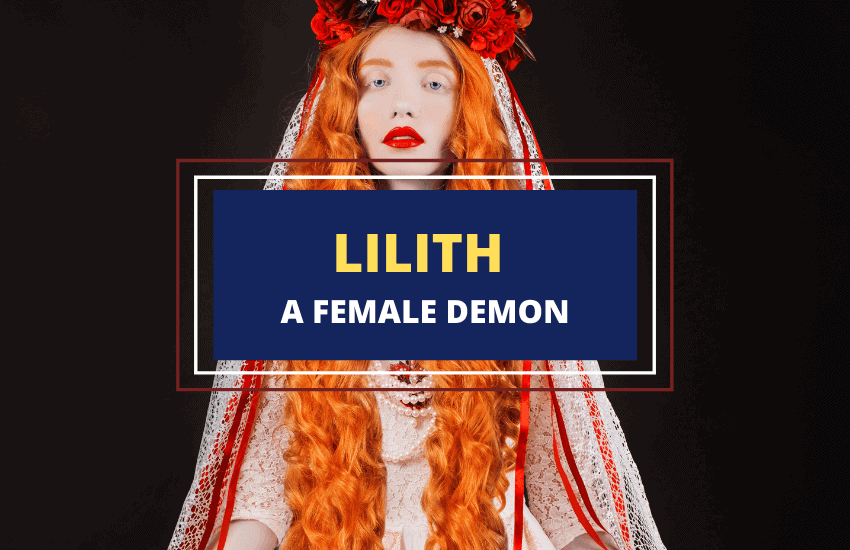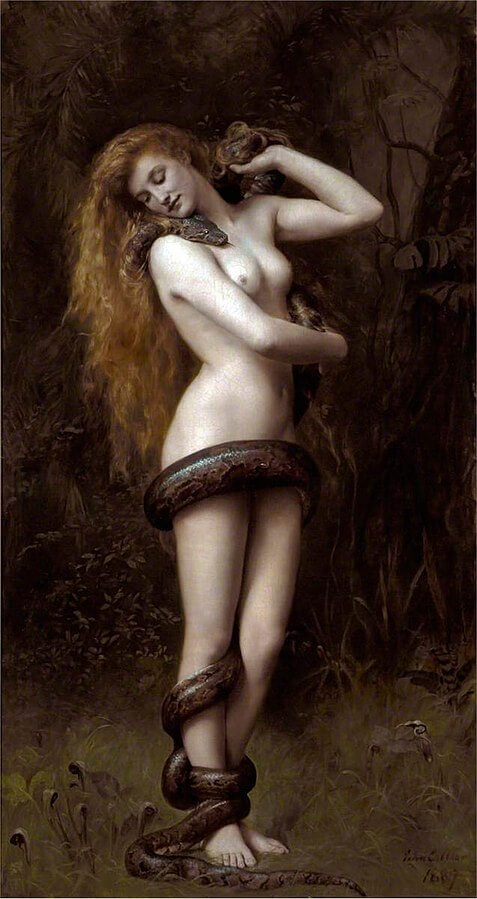
Table of Contents
In Jewish folklore and Mesopotamian mythology, Lilith was a female demon associated with death, illness, sexual temptation and disease. According to ancient Jewish writings, Lilith was said to have been the first wife of Adam, before Eve ever came into existence. However, she refused to be submissive to Adam and left the Garden of Eden.
Let’s take a closer look at Lilith’s story and how she came to be known as one of the most deadly and terrifying demonic figures in Jewish mythology.
Who Was Lilith?

According to the legend, Lilith was created exactly in the same way as her husband, Adam. It was said that God even used the same clay but He also used some residue and filth which was the reason why Lilith later developed her evil demonic traits.
Although Lilith was supposed to live in the Garden of Eden with Adam, she was strong and independent and thought of herself as Adam’s equal since she was created in the same way he was. Therefore, she refused to copulate with Adam and their marriage failed, resulting in Lilith leaving the Garden.
Since Adam began to feel lonely without his wife, God decided to create a second wife for him. This time, He took one of Adam’s ribs and from it he created Eve. Eve, unlike Lilith, was subservient to her husband and the pair lived happily together in the Garden of Eden.
Since Lilith was independent from Adam she was recognized as the world’s first feminist and was even embraced by the feminist movement. An interesting passage about Lilith can be found in the Alphabet of Ben Sira, which details a fiery exchange between Lilith and Adam.
When God created the first man Adam alone, God said, “It is not good for man to be alone.” [So] God created a woman for him, from the earth like him, and called her Lilith. They [Adam and Lilith] promptly began to argue with each other: She said, “I will not lie below,” and he said, “I will not lie below, but above, since you are fit for being below and I for being above.” She said to him, “The two of us are equal, since we are both from the earth.” And they would not listen to each other. Since Lilith saw [how it was], she uttered God’s ineffable name and flew away into the air. Adam stood in prayer before his Maker and said, “Master of the Universe, the woman you gave me fled from me!”
This passage showcases Lilith’s strength of character and the fact that she didn’t want to be bossed by Adam but wanted respect and equality. As Bible scholar Janet Howe Gaines states, “Lilith’s desire for liberation is thwarted by a male-dominated society”.
In an alternate version of the story, she was demonized only after she refused to stay in the Garden of Eden and left it voluntarily.
Lilith as The ‘Dark Goddess’
Lilith’s name is derived from ‘lilitu’, the Sumerian word meaning female demon or wind spirit and she’s often described in ancient texts with other demons. She was also said to have a connection with Sumerian witchcraft.
Lilith was known as the most notorious of all demons in Jewish mythology. She loved to prey upon women and children, lurked behind doors, waiting for her chance to strangle newborns or infants to death. She also had the power to instigate disease in the newborn children and pregnant mothers resulting in miscarriages. Some believed that Lilith would transform herself into an owl and drink the blood of infants and newborns.
According to the Babylonian Talmud, Lilith was a very dangerous and dark spirit, a demon of the night with an uncontrollable sexuality. It was considered dangerous for a man to sleep alone at night since she would appear at his bedside and steal his semen. She fertilized herself with the semen she stole in this manner and she mothered hundreds of demons (or as some sources say, an infinite number of demon offspring). Some say that Lilith gave birth to more than one hundred demons a day.
In some accounts, Lilith was either the first vampire or gave birth to the first vampires ever to exist. This is closely linked to ancient Jewish superstitions that she turned herself into an owl and drank the blood of little children.
Lilith and the Angels
After Lilith left the Garden of Eden, Adam requested God to find her and bring her back home so God sent three angels to retrieve her.
The angels found Lilith in the Red Sea and they informed her that if she didn’t return to the Garden of Eden, a hundred of her sons would perish each day. However, Lilith refused. The angels told her that the only other option for her would be death but Lilith wasn’t afraid and again she refused. She said that God had created her to be in charge of all the newborns: boys from birth until the eighth day of life and girls until the twentieth day.
The angels then made Lilith swear that any infant who wore an amulet with their image on it would be protected and that she would not be able to use her powers over the child. To this, Lilith reluctantly agreed. From that point on, she was unable to harm any children or pregnant mothers who either wore amulets or hung plaques with the angels names or images on them over their homes. Children were given amulets and asked to keep them on their person at all times to protect them from the demoness.
Since Lilith had refused to return to the Garden of Eden, God decided to punish her. If she couldn’t slay at least one human infant because of the protective amulet, she would turn against her own children and one hundred of them would perish daily.
Lilith Returns to the Garden of Eden
According to some versions of the story, Lilith was jealous of Adam and Eve because they lived in peace and happiness in the Garden of Eden. Plotting to take revenge on the pair, she transformed herself into a serpent (which we know as Lucifer, or Satan) and returned to the Garden.
In the form of Lucifer, the serpent, Lilith convinced Eve to eat the forbidden fruit which resulted in Adam and Eve having to leave the paradise.
Depictions and Representations of Lilith
In Sumeria, Lilith was often depicted as a beautiful winged woman with the feet of a bird and wearing a horned crown. She’s usually flanked by two owls, nocturnal and predatory birds that are considered a symbol closely associated with the demoness. The objects she holds in each hand are symbols connected with divine authority. All residents of the Underworld used large, demon wings as their mode of transport and Lilith did the same.
In some images and art Lilith is portrayed standing on the back of two lions, which she seemed to bend according to her will. Throughout history, she has been depicted in many works of art as well as on plaques and reliefs, especially in Babylon where she was said to have originated. On some reliefs, she’s portrayed with the upper body of a woman and the tail of a serpent instead of a lower body, much like Echidna in Greek mythology.
Lilith was a famous figure in the Egyptian, Greek, Roman, Israelis and Hittite cultures and later, she became popular in Europe as well. She mostly represented chaos and sexuality and was said to have cast all kinds of dangerous, evil spells on people.
Lilith in Popular Culture
Today, Lilith is a popular symbol of freedom of feminist groups throughout the world. Women began to realize that they could, like Lilith, be independent and they began to look upon her as a symbol of feminine power.
In the 1950s, the pagan religion Wicca, came into existence and the Wicca followers began to worship Lilith as the ‘dark goddess’. She became an important symbol associated with the Wicca religion during this time.
Over time, Lilith has developed into a distinct character in popular culture, appearing countless times in comic books, video games, supernatural films, TV series, cartoons and so on. Her name is extremely popular and she’s viewed by many people as the mysterious, dark goddess or the first woman on Earth who fought for her independence regardless of the price she had to pay.
In Brief
Lilith is known to be one of the most terrifying and deadly demonic figures in Jewish mythology. However, she’s also an important symbol among feminists, who respect her for her strength and independence. Her story remains a subject of mystery and much interest.








